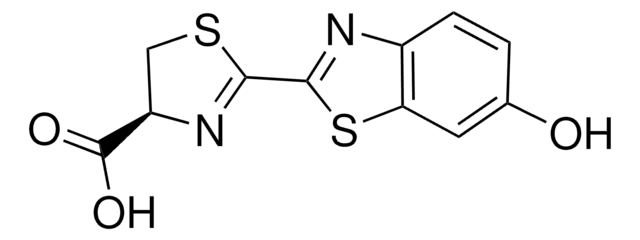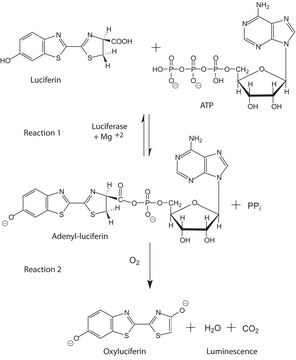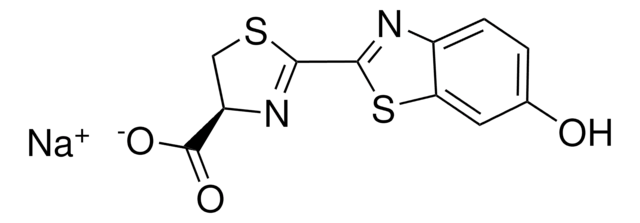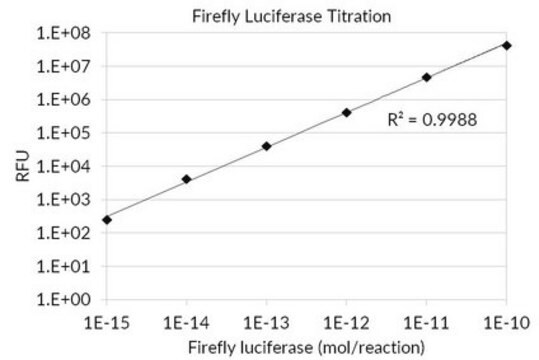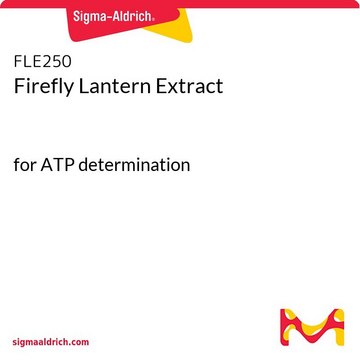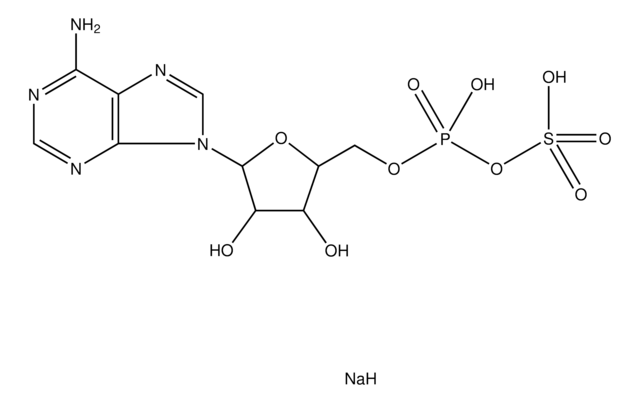Key Documents
L9420
Luciferase from Photinus pyralis (firefly)
recombinant, expressed in E. coli, buffered aqueous solution, ≥10×1010 units/mg protein
Synonim(y):
Luciferase firefly
About This Item
Polecane produkty
rekombinowane
expressed in E. coli
Poziom jakości
Próba
≥98% (SDS-PAGE)
Postać
buffered aqueous solution
aktywność właściwa
≥10×1010 units/mg protein
masa cząsteczkowa
62 kDa
Warunki transportu
dry ice
temp. przechowywania
−20°C
Szukasz podobnych produktów? Odwiedź Przewodnik dotyczący porównywania produktów
Opis ogólny
Zastosowanie
Definicja jednostki
Unit Definition Conversion Factor: There are approximately 9000 Relative Light Units (RLU) per one traditional Light Unit that uses a peak height equivalent to 0.02 μCi of 14C in a PPO/POPOP cocktail.
Postać fizyczna
Hasło ostrzegawcze
Danger
Zwroty wskazujące rodzaj zagrożenia
Zwroty wskazujące środki ostrożności
Klasyfikacja zagrożeń
Acute Tox. 4 Oral - Resp. Sens. 1 - STOT RE 2 Oral
Organy docelowe
Kidney
Kod klasy składowania
10 - Combustible liquids
Klasa zagrożenia wodnego (WGK)
WGK 3
Temperatura zapłonu (°F)
231.8 °F
Temperatura zapłonu (°C)
111 °C
Certyfikaty analizy (CoA)
Poszukaj Certyfikaty analizy (CoA), wpisując numer partii/serii produktów. Numery serii i partii można znaleźć na etykiecie produktu po słowach „seria” lub „partia”.
Masz już ten produkt?
Dokumenty związane z niedawno zakupionymi produktami zostały zamieszczone w Bibliotece dokumentów.
Klienci oglądali również te produkty
Produkty
Bioluminescence imaging (BLI) systems allows for high-sensitive and noninvasive monitoring of cell proliferation, activity of signaling pathways and protein-protein interactions in living tissues.
Overall results suggest that seMpai is a suitable substrate of near-infrared BLI for many biological experiments. Its high solubility in neutral buffer conditions further extends the bioluminescent application of TokeOni derivatives.
Lucyferaza Firefly jest czułym reporterem do badań genów ze względu na jej brak w komórkach lub tkankach ssaków.
Firefly luciferase is a widely used bioluminescent reporter for studying gene regulation and function. It is a very sensitive genetic reporter due to the absence of endogenous luciferase activity in mammalian cells or tissues.
Nasz zespół naukowców ma doświadczenie we wszystkich obszarach badań, w tym w naukach przyrodniczych, materiałoznawstwie, syntezie chemicznej, chromatografii, analityce i wielu innych dziedzinach.
Skontaktuj się z zespołem ds. pomocy technicznej
